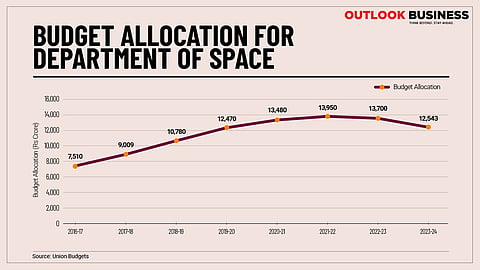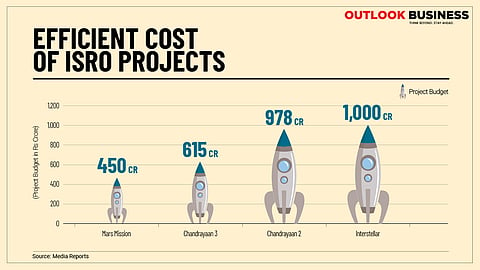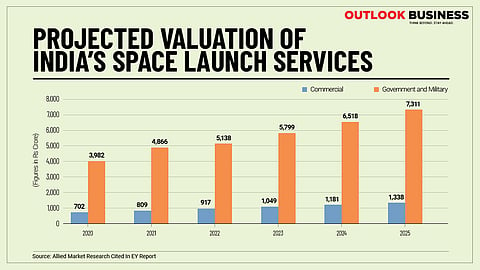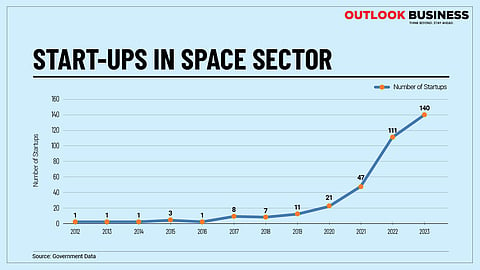With the imminent launch of India’s third lunar mission, Chandrayaan 3, on July 14, all eyes are set on the Satish Dhawan Space Centre located in Sriharikota. Through this new mission, Indian Space Research Organisation (ISRO) is aiming to land a rover on the surface of Moon which it failed to do in its previous attempt in 2019.
Chandrayaan 3: How India Is Fuelling Its Space Economy As More Private Players Enter The Sector
Chandrayaan 3 mission will attempt a landing on moon
Chandrayaan 2 consisted of an orbiter, lander and a rover. The mission had failed in the final stage when India’s space organisation lost contact with the lander and rover. However, learning from its previous mistake, ISRO is all set to attempt the landing again in the Chandrayaan 3 mission.
Explaining the mission on its website, ISRO said, “Chandrayaan 3 is a follow-on mission to Chandrayaan 2 to demonstrate end-to-end capability in safe landing and roving on the lunar surface. It consists of lander and rover configuration.”
From the successful Mars mission to the ambitious goal of landing a rover on the lunar surface, India has been looking to establish its place in space research. Over the years, ISRO has also been trusted by the foreign players to launch their satellites which reflects the growing heft of the space organisation in the global space economy. A look at the data for budget for department of space, valuation of space launches and the growing number of private players point to the rising stars of India’s space sector.
Allocation For Department Of Space

The latest budget for financial year 2023-24 presented by Finance Minister Nirmala Sitharaman allocated Rs 12,543 crore for the department of space under which ISRO operates. While the budgetary allocation for this fiscal has declined slightly, the funding for the space department has seen a significant rise in the last six years. As India plans big space projects like the Gaganyaan mission in the coming years, the allocation of budget has become all more important for the funding of ISRO projects.
When it comes to funding of India's space missions, the efficient costs of ISRO projects, which lower than many famous movies, has managed to grab headlines time and again.
Costs Less Than A Movie

The costs of some of the major ISRO projects in the last 10 years show how the space organisation has been able to efficiently utilise resources to launch missions. The amount spent to reach Mars and Moon in the last few years has been lower than the budget of Christopher Nolan’s Interstellar which was released in 2014. ISRO’s efficient costs have been time and again been in the news. Outlook had earlier reported that the focus on indigenisation programmes for critical components and the lower cost to hire talent in India have been some of the factors which help the space organisation keep its costs under check.
Not only efficient use of resources, ISRO has also been able to rake in significant revenue through its commercial arm in the last few years. Union Minister Jitendra Singh had informed that between 2019 and 2021, the organisation earned around Rs 288 crore by launching missions of various private and international agencies. The valuation of space launch services has been projected to grow at a strong pace in the coming years as well, with more players entering the sector.
Space Launch Potential

According to Ernst and Young’s (EY's) Developing the space ecosystem in India report published in October 2022, the market for space launches is all set to grow in the coming years due to economical launch services, rise in navigation satellites, and increasing demand for communication satellites. It said, “The launch segment is fast becoming a key focus area for startups and small and medium businesses (SMEs) in India to drive the innovation agenda and make use of new revenue opportunities.”
Looking at the potential of private players, Indian government had launched the Indian National Space Promotion and Authorization Centre (IN-SPACe) to oversee activities in the sector. According to the official mandate, the activities include building of launch vehicles, satellites, providing space based services, sharing of test facilities and setting up incubation centres.
Government had allocated Rs 33 crore in financial year 2023 for IN-SPACe which grew to Rs 95 crore in the current fiscal. Recognising the opportunities presented by the space sector, more and more private players are entering the space economy of the country.
Rising Start Ups

The number of start-ups starting operations in the space sector has touched an all-time high with a strong growth seen in the last few years. Commenting on the rising number of start-ups, Union Minister Dr Jitendra Singh said at an event held recently that India has gained a strong footing in the space sector and the world is now recognising India’s potential. He also termed the emerging role of private sector as pivotal to India’s space economy. EY in its report also said that the entry of private players in the sector will make India’s space industry competitive.